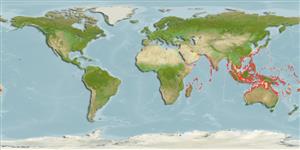Teleostei (teleosts) >
Eupercaria/misc (Various families in series Eupercaria) >
Lutjanidae (Snappers) > Lutjaninae
Etymology: Lutjanus: Malay, ikan lutjan, name of a fish.
More on author: Bloch.
Environment: milieu / climate zone / depth range / distribution range
Ecology
Marine; reef-associated; depth range 2 - 40 m (Ref. 9710). Tropical; 35°N - 37°S, 42°E - 176°W (Ref. 55)
Indo-West Pacific: Persian Gulf and the Gulf of Oman to Fiji, north to southern Japan. This species has been referred to as Lutjanus spilurus.
Size / Weight / Age
Maturity: Lm ? range ? - ? cm
Max length : 38.0 cm TL male/unsexed; (Ref. 55); common length : 30.0 cm TL male/unsexed; (Ref. 5450); max. reported age: 31 years (Ref. 34051)
Dorsal spines (total): 10; Dorsal soft rays (total): 13 - 15; Anal spines: 3; Anal soft rays: 8. Dorsal profile of head steeply sloped. Preorbital width usually less than eye diameter. Preopercular notch and knob well developed. Scale rows on back rising obliquely above lateral line. Generally bright yellow, including fins, with a series of blue stripes on the side. A round black spot, about the size of the eye or larger, is below the anterior most soft dorsal rays, touching the lateral line but mostly above it (Ref. 469). Body depth 2.3-2.9 in SL (Ref. 90102).
Adults inhabit sheltered lagoons and exposed, outer slope coral reefs. Frequently encountered in large aggregations including 100 or more individuals at moderate depths, usually in 30-40m, like in some Pacific locations (Ref. 48635). Juveniles solitary and shallow in protected bays with algae and rubble substrates. They feed mainly on fishes and crustaceans (Ref. 4533).
Life cycle and mating behavior
Maturities | Reproduction | Spawnings | Egg(s) | Fecundities | Larvae
Allen, G.R., 1985. FAO Species Catalogue. Vol. 6. Snappers of the world. An annotated and illustrated catalogue of lutjanid species known to date. FAO Fish. Synop. 125(6):208 p. Rome: FAO. (Ref. 55)
IUCN Red List Status (Ref. 130435)
Threat to humans
Harmless
Human uses
Fisheries: commercial; gamefish: yes; aquarium: commercial
Tools
Special reports
Download XML
Internet sources
Estimates based on models
Preferred temperature (Ref.
123201): 24.7 - 29.1, mean 28.2 °C (based on 1068 cells).
Phylogenetic diversity index (Ref.
82804): PD
50 = 0.5000 [Uniqueness, from 0.5 = low to 2.0 = high].
Bayesian length-weight: a=0.01349 (0.00887 - 0.02052), b=2.98 (2.86 - 3.10), in cm total length, based on LWR estimates for this species & Genus-body shape (Ref.
93245).
Trophic level (Ref.
69278): 3.7 ±0.2 se; based on diet studies.
Resilience (Ref.
120179): Low, minimum population doubling time 4.5 - 14 years (tmax=31; k=0.22-0.37; Fec>160,000).
Prior r = 0.33, 95% CL = 0.22 - 0.49, Based on 1 data-limited stock assessment.
Fishing Vulnerability (Ref.
59153): Low to moderate vulnerability (34 of 100).
Climate Vulnerability (Ref.
125649): High vulnerability (56 of 100).
Nutrients (Ref.
124155): Calcium = 39.6 [26.6, 57.1] mg/100g; Iron = 0.348 [0.224, 0.529] mg/100g; Protein = 18.4 [16.9, 19.7] %; Omega3 = 0.128 [0.090, 0.177] g/100g; Selenium = 52 [36, 76] μg/100g; VitaminA = 163 [30, 588] μg/100g; Zinc = 0.508 [0.408, 0.695] mg/100g (wet weight);
